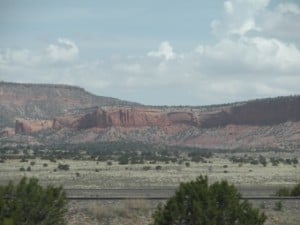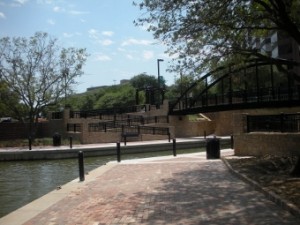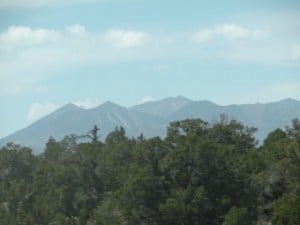This post for me marks a milestone: it’s my 100th.
Travels being one of the tags, I thought: why not devote my 100th to writing about a road trip? So, that’s what’s on tap.
Following is a synopsis of my May 2012 California-Texas-California road trip in words and pics.
All roads lead to the Lone Star State

Late spring/early summer beckons one to venture out. In fact, a few photos included on this blog were of places seen while on a road trip I made last year to Dallas-Ft. Worth and back. One of those is again re-posted here in addition to new ones not already featured. Over the summer, two more trips took me to the San Francisco Bay Area where I ventured to Corte Madera and San Rafael. Those too were car trips.
Taking six days to complete the California-Texas-California trek, I traveled through such familiar places as Bakersfield, Tehachapi, Barstow and Needles in the Golden State; Flagstaff, Williams, Winslow and Kingman, Arizona (with its ties to the famous Route 66 – made popular in song); Albuquerque, Gallup, Santa Fe and Tucumcari, New Mexico; and Amarillo, Wichita Falls and Dallas-Ft Worth, Texas.
I thought California, Arizona and New Mexico were big. Then I saw Texas. Now, that’s what I call big! Texas-sized big, in fact.
Observations

Here is what I had observed about the Dallas-Ft. Worth area. For one, it’s rolling hill country. As such, there is mucho urban and suburban land development. Furthermore, there is a sprawling metro airport complex (DFW International).
Additionally, there are “un”-tolled highways – and tolled ones too. And, of course, what would all of the roadway infrastructure be without traffic? There is plenty of that as well.
Furthermore, if I failed to mention the extensive public transit network – Dallas Area Rapid Transit (DART), Trinity Railway Express (TRE) and the Las Colinas Area Personal Transit (APT) – I would certainly be remiss. My apologies if I missed any.
Heading back
Wasn’t it novelist Thomas Wolfe who once said you can never go home? If it is, I think he’s wrong. As a matter of fact, after my exit from Texas, this is exactly what I did.
Trading in the big city scene for the open road – and I do mean “open,” in leaving Dallas-Ft. Worth I pointed my vehicle to the northwest and once onto highway 287, I drove for 300 miles to Amarillo, much of it through vast open prairie- or range-lands – there’s that word “open” again. It’s a good six-hour drive – easy.
The highway is paralleled by the Burlington Northern Santa Fe Railway. I believe this was part of the old Denver & Ft. Worth (D&FW) and on this railroad, coal seems to be king.
Amarillo, in the panhandle area, and points west, seem to me to have roots in agriculture. The multiple silage silos, seen along I-40, stand as testament to that.
Upon crossing over into New Mexico, the terrain undergoes quite a transformation. Greenery there seems greener.
The Land of Enchantment (New Mexico) was “airy,” and by that I mean there are wide open spaces with scenic vistas galore, especially along Interstates 40 and 25 and, as well, on some secondary thoroughfares. The interesting feature that stands out most in my mind is the red rock desert area in the western half of the state and on into eastern Arizona as well.

It’s quite a climb up into the high country area of Santa Fe. There in the state’s capital, a fierce wind was a blowing. But, I have to admit, the air appeared fresh, clean and pristine. Seems Santa Fe and its air have those qualities in common.
Over on into Arizona, in approaching Flagstaff, the flora changes dramatically as green ground cover and scattered trees gave way to towering pines as far as the eye could see. There is no mistaking the splendor of the Flagstaff area with the San Francisco Peaks making for a majestic backdrop.
In wintertime, there is even snow skiing and presumably snowboarding in them thar hills. Another feature, the Grand Canyon, is not too far away.

Leaving Flagstaff, it’s literally all downhill from there until bottoming out basically at Kingman, Arizona. Surrounding hills have a rugged, rocky look about them. Make no mistake.
Just prior to entering California, I crossed the river Colorado. Not unlike in Texas, the Burlington Northern Santa Fe Railway (the former Atchison, Topeka and Santa Fe this time) parallels I-40 west of Albuquerque all the way to Barstow. Incidentally, from Needles (on the Arizona-California border) to Barstow it’s desert, desert and more desert.
The home stretch

To me there is one word and one word only that typifies Barstow: trains.
Proceeding northwest, highway 58 consists of many rolling hills. Hinkley, thrust into the spotlight in the 2000 film Erin Brockovich, is bypassed here.
And another town, Boron, got its claim to fame, it appears, by a mule team of all things. It, however, is not bypassed. Highway 58 runs through it.
Next up is Mojave. From there it is a pretty good ascent to Tehachapi, home to the famous “loop,” where trains of the Union Pacific and Burlington Northern Santa Fe encircle themselves if they’re long enough. Meanwhile, on the top of the mountain that flanks the highway off to the south between Mojave and Tehachapi, are those ever-present and unmistakable wind turbines, you know, the ones generating electricity cleanly.

Tehachapi being the summit, 58 winds and descends its way into Bakersfield (home of Country music legends Buck Owens and Merle Haggard) in California’s San Joaquin Valley where, apparently, ag and oil have somehow maintained a peaceful coexistence. About a hundred miles or so farther on up the road, State Route 99 in this case, is where I and California’s center – Fresno, the raisin capital of the world – reside.
Three days over and three days back; back to where, for me, it all started.
– Alan Kandel